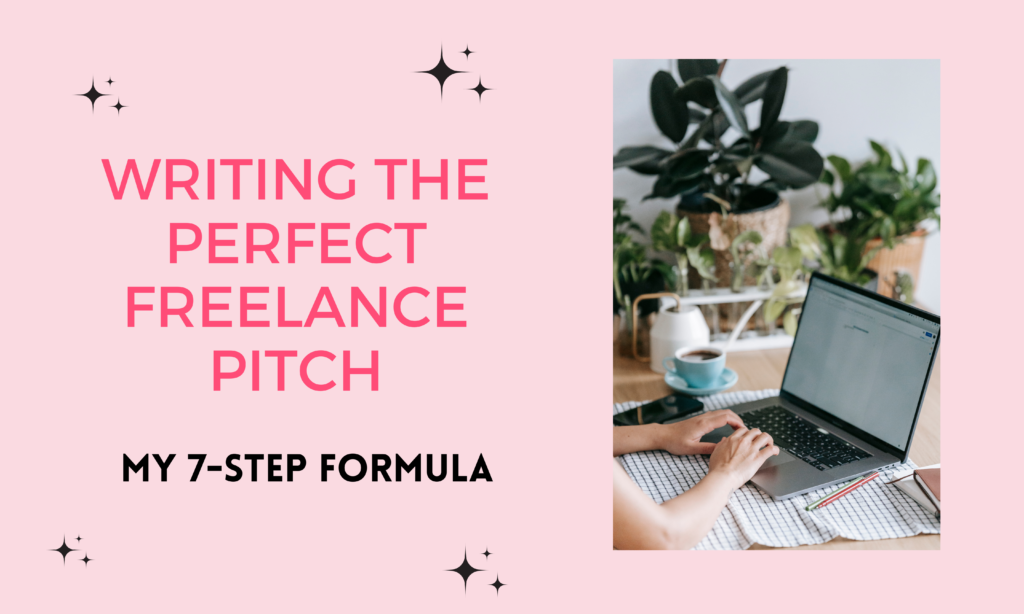Let’s be real…
Brainstorming story ideas as a freelance writer is fun, exhilarating, and energizing! But sitting down to craft them into pitches… Yeah, not so much.
After living the freelance writer life for nearly two years, and sending over 200 pitches to editors, I’ve fine-tuned the process to make it as quick and painless as possible.
To take out the guesswork, here are my top 7 tips for sending freelance writing pitches to editors.
They’ve helped me land stories in Business Insider, Well+Good, Verywell Mind, and several other top publications! And I want them to help you, too.
Let’s dive in.
1. Familiarize yourself with the publication
Not every story idea will fit into every publication. Some appeal to a Gen Z audience, while others are targeted at 60 and over crowds. Certain publications might want listicle-style stories, while others seek long-form reported features.
Before you decide which media outlet, newspaper, or literary magazine to send your freelance writing pitch to, you want to:
- Read a few stories from the publication. This will familiarize you with the publication’s tone, target audience, and topics covered. You’ll also get an idea of the types of stories they publish often— personal essays, reported features, interviews, etc.
- Conduct a search within the publication’s website. Type main keywords related to your story idea into the search bar on the publication’s website. This can help you determine whether similar stories have been covered before, and if so, how you can approach your idea from a unique angle (more on that soon). For example, if you’re writing about imposter syndrome as a writer, start by searching “imposter syndrome writer.”
2. Start with a catchy headline
Your headline is the first impression you’ll be giving the editor. That’s why it’s important to make it catchy— don’t be afraid to be bold, sassy, funny, or steamy!
In your subject line, include your headline as, “PITCH: [Your Proposed Headline].”
In the body paragraph, include it as “Hed: [Your Proposed Headline].” (For all the non-journalist folks, “Hed” is journalism lingo for “headline”—don’t worry, it took me a while to figure this one out, too!)
Your editor will likely tweak your headline, but starting off with a strong one can make it a lot less difficult for them to do so.

3. Use a Compelling Opening Statement
Once you start your email, introduce yourself in two-three sentences, then jump into the story idea!
Start off with an interesting fact, question, quote, or anecdote. Like your headline, your opening statement— or “hook”— holds a lot of power. Remember, the main goal is to get the editor to keep reading your freelance writing pitch.
4. Answer the two big “why”s
There are two big questions your freelance writing pitch should answer. It doesn’t matter how you answer them or where, but the final pitch should cover them. The two questions are:
- Why should the publication cover the story now? Is it tied to current events? An upcoming heritage/awareness month? A trending topic in the media? (Pro Tip: I highly recommend Selena Soo’s publicity calendar, which will give you an idea of what holidays, awareness months, etc. occur each month. Sign up at her website here.)
- Why are you the one to tell the story? Which new perspectives are you adding to the conversation? This is your chance to brag— so if you have credentials or experience that are worth mentioning (or tie into your story), list them here!
5. Keep It Brief
I know it’s tempting to flesh out as much of the story as possible…
But trust me, editors will get overwhelmed if you get into too much detail. Unless the editor or submission guidelines specifically asked for a full first draft, do not send a whole story in your freelance writing pitch.
Keep it brief— aim for 300 words— and focus on key points. What are the main concepts, takeaways, or lessons you’ll be covering? List those out in one or two sentences each, and leave it at that.
If you plan to interview people or consult sources, list those here, as well.
6. Include Writing Samples
At the end of your email (before you sign off), leave links to relevant writing samples. For instance, if your story idea is about travel, include links to travel-related writing you’ve done. These can be as simple as blog posts— no need for anything fancy!
If you don’t have any relevant writing samples, include anything that showcases your best work. You can also leave a link to your portfolio.
But wait, what if I haven’t written anything before?
I know the struggle… I had the same question when I was first starting out! My best advice is to start a blog, write a post on Medium, or offer to write a blog post on a friend or acquaintance’s website for free.

7. Follow Up After 2 Weeks
Editors are busy people.
Their inboxes are flooded with press releases, freelance writing pitches, and work-related requests. It’s normal for them to take several days to sift through the hundreds— if not thousands— of emails they receive each week.
Based on my own experiences, I’ve found it helpful to reach out after two weeks if you haven’t heard anything. Something simple like, “Hi [editor’s name]! Just wanted to circle back with this story idea and get your thoughts,” is sufficient.
A couple of times, editors have commissioned story ideas after I followed up! And several other times, they gave me the “we’ll pass” spiel that let me know I could send the freelance writing pitch to another publication.
Other Points to Keep in Mind
When sending freelance writing pitches, you’ll also want to follow a few do’s and dont’s to make the most of the process:
DO:
- Keep a spreadsheet to keep track of your freelance writing pitches. This can help you develop an organized system for visualizing which ideas have been accepted, denied, followed up on, or are awaiting a response. (If you’re a data nerd like me, you can even calculate how many pitches you sent, were accepted, etc.)
- Include links to your website/social media accounts in your pitch. Whether you include it in your signature or mention it in a separate sentence towards the end, this can further add to your credibility.
- Incorporate in-text links to previously published articles in the publication. Editors love this! It shows that you’ve read other articles on the site (or — at the very least— did your research), and can help reinforce ideas you want to build upon or conversations you’d like to add to. (See step 4.)
DON’T:
- Send the same version of a pitch to different editors. Your story idea is special, and you’ll want to send it to multiple outlets to increase your chances of getting that big “YES!” However, editors don’t want to see a copy-and-paste version of your freelance writing pitch that you sent to 20 other people. Personalize your pitch to each publication. Be sure to tweak the angle if it needs tweaking, and refer to the editor by their first name.
- Include graphics, complex fonts, or large blocks of text in your email. Editors have a million tasks on their daily to-do lists, meaning their attention spans are finite. Keep your email simple in terms of appearance and easy to read. This means avoiding graphics or photos, making your fonts hard to read, or writing large blocks of text. My rule of thumb for the latter point is to include 2-3 sentences per paragraph (and this applies to all emails, not just freelance writing pitches).
Final Takeaways
Sending pitches as a freelance writer can feel daunting at first. But with these tips, sending freelance writing pitches can become a more streamlined process. I hope they help you send out more pitches, and land stories in your dream publication!
P.S. If you used these tips and your story idea was accepted, send me a link to the final version! I’d love to see it!


